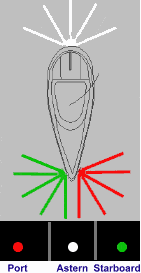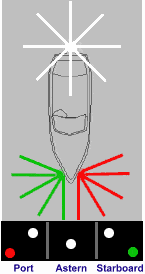How to Navigate in Restricted Visibility
Operating a boat during times of restricted visibility can be dangerous. Whether at night or during mist and fog. If you can’t see you need to be cautious. For this reason, safety signals have been devised. You need to rely on light signals and sound signals. Knowing the meaning of these light signals and sound signals ensures your safety. Also, the safety of other boaters on the water.
Let’s take a look at the navigation rules you need to know. The sound signals and navigation lights you need to know. These make you visible to other boaters and make boating safer for all vessels.
What is Restricted Visibility?
You may be tempted to think restricted visibility means that there is something in your way. The words make it sound like you have an obstructed view of where you are going. That’s not technically true.
On a boat, restricted visibility is anything that prevents you from seeing or being seen. The most common causes of restricted visibility are:
- Night. Obviously it’s hard to see a boat at night, and to navigate around obstacles in the dark. At sunrise and sunset it can be difficult to make out shoreline features. Small boats may also be hard to identify. In total darkness depth perception suffers. Lights from shore and other boats can be disorienting.
- Weather. Mist, fog, and rain storms can all cause restricted visibility. You need to be cautious in poor weather as a result. If a storm is bad enough, visibility can be reduced to just a few yards.
The danger of restricted visibility is multi-faceted. Not being able to see where you are going is a hazard in terms of obstacles on and in the water. This includes other boats, reefs, rocks and more.
Additionally, no one is able to see you. Other boats need to know your location at all times on the water. Thus, there are navigation rules to use during periods of restricted visibility.
What Are the Rules for Restricted Visibility?
When you are boating during times of restricted visibility, you need to slow down. Caution is always the best approach. The only time increased speed is advised is to avoid a collision.
As a boater, if you hear another boat’s fog signal you must reduce speed. This also applies when you are in close quarters with another vessel. As well, if you detect a vessel on radar. Speed should be reduced to the minimum that allows you to stay on course.
Your boat is equipped with navigation lights and sound signals. You’ll need to make constant use of these to help you with navigation. An important thing to remember is that not every boat follows these rules. Even though legally they are required, some boats will not have navigation lights. That is why responsible boaters need to be cautious and attentive. You can’t rely on other boaters to follow the rules.
Light Signals for Restricted Visibility
Display of navigation lights is mandatory. Their use tells other vessels on the water which boat is the stand-on or give-way vessel. Understanding them is the difference between smooth sailing and a potential accident.
- A vessel approaching from your vessel’s starboard side will show a red port light. Your starboard is the danger zone. The red light indicates stop.
- From your starboard side the vessel will see your green starboard light. This means you have the right of way.
- If the approaching vessel has no masthead light that means it is not a power-driven vessel. Something like a sailboat qualifies as not a power-drive vessel. This is important to know. Anything that is not a power driven vessel has the right away over boats that are power driven.
- If a boat is being towed and is therefore not under its own power, it also doesn’t qualify as a power-driven vessel. This too would have the right of way over power-driven boats.
- In very bad conditions, such as heavy rain, visibility may be very restricted. These lights can be hard to see. That is why sound signals are also used. The two work together to ensure maximum visibility. Nonetheless, caution is job one. Speeds should always be reduced.
What Are the Lights on a Boat?

Boats are required to have several kinds of lights on display. These can change depending on whether the boat is power driven or not.
Masthead Lights: All power driven vessels are required to have a masthead light. This is a white light that shines forward and to the sides. If a vessel does not display a masthead light, then it is a sailing vessel.
Stern Light: This is a white light visible from the rear of the boat.
Side Lights: As the name suggests, these lights are mounted on the sides of the boat. On the vessel’s port side is a red light. On the vessel’s starboard side is a green light. On a sailboat these may be on the top of the mast. In that case they are called combination lights. They can also be mounted as combination lights on the bow. Regardless of location, the colors must be the same. Red is left or port. Green is right or starboard.
All-Around Light: This is a white light. A power driven vessel less than 39.4 feet may use this light. In that case it combines the masthead light and the stern light. The result is a single white light visible from every side of the boat. The all-around light can be used as an anchor light. This will happen when the sidelights are not in use.
Sound Signals for Restricted Visibility
Vessels with a motor will need to use sound signals to alert other boaters. In a technical sense, sound signals can be produced by anything. You could literally bang pots and pans if it was an emergency. However, you should have access to a whistle or horn, gong and a bell for proper signals. Anb actuarial whistle can also be used, but it’s generally for smaller boats.
Inland and international rules require the use of sound signals.
- Power driven boats should one prolonged blast every two minutes.
- Sailing vessels should sound one prolonged blast. This is then followed by two short blasts every two minutes.
- There are other times when the sound signal used is one prolonged blast followed by two short blasts. This includes:
- A vessel not under command
- A vessel constrained by her draught
- A fishing vessel
- A vessel towing another craft
- A vessel with restricted ability to maneuver
- This also includes fishing vessels and vessels that can’t maneuver when that are at anchor
- If you are in a power drive vessel that is stopped, things change. This is called underway but making no way. In this case you must sound two prolonged blasts every two minutes.
- A vessel that is at anchor needs to sound 5 rapid bell strokes every minute.
- In some cases this is not necessary. A boat that is under 65 feet and anchored in a designated “special anchorage” doesn’t need to do this.
- If the boat is over 100 meters, a gong signal will also be sounded. The gong signal sounds rapidly for 5 seconds after the bell.
- If your vessel has run aground three clear bell strokes are needed. This is followed by 5 seconds of rapid ringing. Then three more clear strokes.
- A gong signal may also apply for a vessel over 100 meters.
- A manned vessel being towed has rules as well. It must sound one prolonged blast followed by three short blasts. This must be done every two minutes. On the off chance more than one vessel is being towed, the last vessel does this. Again, only if manned.
Rules for Making Sound Signals
As you have seen, three different tools are needed for making sound on a boat. A horn, a gong, and a bell. When you read regulations you may see the word whistle uses. For most purposes, the air horn is the whistle on the boat. The terms are used interchangeably. There are rules for how you make these sounds.
Horn or Whistle: If you have a larger vessel you horn needs to meet standards. The blast should be able to be heard between 1.5 and 2 nautical miles away. It should register at 143 decibels. That places it just at the threshold of inducing pain. For that reason, it is to be mounted near the highest point of a boat. It should not be near enough to crew to cause damage.
Bell: The bell on your boat needs to be corrosion resistant. According to regulations “The diameter of the mouth of the bell shall be not less than 300 mm for vessels of more than 20 meters in length, and shall be not less than 200 mm for vessels of 12 to 20 meters in length.” The striker needs to be no less than 3% of the mass of the whole bell. It also needs to be designed for manual operation. However, it can operate under power as well.
Gong: The gong must also be corrosion resistant. The sound it makes must be clear. It must also be distinguishable from the sound of a bell. Which is to say if someone hears it, they can’t be thinking it’s a bell.
It’s worth noting that you do not technically need a literal bell, whistle, and gong. Devices that are capable of making sounds to mimic these devices are acceptable. For that reason you will see many boats with three separate horns mounted on then. Each horn produces a distinct sound. As long as they meet the sound requirements, you do not need to bang a literal gong.
Boating in Fog
Boating in fog is different from other restricted visibility situations. Fog can limit navigation lights. On a clear night you can see a masthead light for miles. In thick fog it becomes diffuse. That can make navigation rules harder to follow. This is one situation in which sound signals quickly become vital.
There are some rules to follow when boating in fog. These make caution and safety a priority. Another vessel may come upon you very quickly in fog. Be wary and follow the rules.
- In heavy fog, reduce speed accordingly. You need to be able to stop in half the distance you are able to see. That means the less visibility the lower the speed. Better safe than sorry if you approach another vessel or some rocks.
- This rule was not written with very small, very fast boats in mind. It’s possible that a speedboat could get away with 40 knots in 50 meter visibility according to this. That would not be ideal. As such, common sense must prevail. You need to have the ability to stop and maneuver. You also need to be cautious.
- Any passengers or crew on the boat should help keep watch. Keep someone at the bow if at all possible.
- Keep track of your position on a chart.
- Keep all navigation lights on so other vessels can see you.
- Ensure proper use of sound signals. That’s one prolonged blast of the horn every 2 minutes. A prolonged horn blast should last 4 to 6 seconds.
- If you do not have a horn on your vessel, a whistle will suffice. Small boats should have an emergency whistle as part of their emergency kit.
- If you anchor the vessel, sound signals will change. You must rapidly ring the bell for 5 seconds every one minute.
Things to Remember
It’s all fine and good to read these rules on paper. Putting them into practice is another thing. You need to be comfortable on your boat at all times. Even a seasoned boater can find restricted visibility stressful. If you are new, it can be overwhelming. Your best bet is to prepare as well as you can.
Learn your boat: Know where everything is and how it works. Understand how to operate your lights and the sound signals. Familiarize yourself with the sounds they make. Practice the signals when you have some time. It just takes a minute or two. It’s good to show these things to crew and passengers as well.
Understand your boat’s speed and maneuverability. Like we said, restricted visibility speed is a grey area. You don’t want to just be barely moving. But you can’t be reckless. Determine a safe pace that allows a quick response in an emergency.
Learn the stopping distance of your boat. This is important to know right away. If you are new to boating or the specific boat you are on. Take it out on open water and get a feel for how it responds.
Check the weather: Fog can roll in unexpectedly. So can rain. But often the weather report is your friend. If you know to expect bad weather, you can prepare for it. Also avoid it if you’re not prepared to navigate in restricted visibility.
Plan your trip. Having a well planned schedule is important. Let others know where you will launch from. Also where you are going and when you will be back. This can help you avoid boating at night if it’s not your plan. And if you get caught out unexpectedly it can help the U.S. Coast Guard find you. Never go boating without letting someone know where you’re going and when.
Check your equipment: Every time you head out, do an inspection. You need to make sure all your lights work. As well, the horn and bell need to be inspected. If you have an air horn, the lines can get jammed up. If the horn is dead, that could cause an accident when you least expect it.
Stay focused: If you were fishing and fog rolls in, considering putting the rods away. Splitting your attention can be dangerous. If you are concerned about visibility, make it your main focus.
Have charts handy: It’s important to know where you are on the water. If you can’t see, charts will help you navigate obstacles. You need to know if there are hazards hidden in the darkness or fog. Many new boaters have trouble reading charts. It’s a good idea to familiarize yourself.
Fix your location and make sure you know where you are. It is very easy to get lost in fog. GPS is extremely helpful but it’s not always 100%. It’s also not going to help you navigate around hazards and other vessels. It’s one tool of many that you can use.
At the end of the day, a paper map and compass will always work.
Keep the radio on: Channel 16 on a VHF radio is for emergencies. Keep your radio on to listen for any potential dangers. A mayday could come through at any time. And you may need to call for help yourself.
Have emergency equipment: You should have an emergency whistle on board. Likewise, flares and a bright flashlight as well. If something happens to your boat’s power, these could be crucial. You’ll want everyone on board to have a lifejacket as well. One that is highly visible.
If you are new to boating there is no shame in wanting to avoid restricted visibility situations at first. It takes time to get comfortable navigating in them. If you find yourself stuck, just follow the rules and stay safe. As long as you are responsible, you should get home safe and sound.
Categories: Boats, nauticalknowhow
















